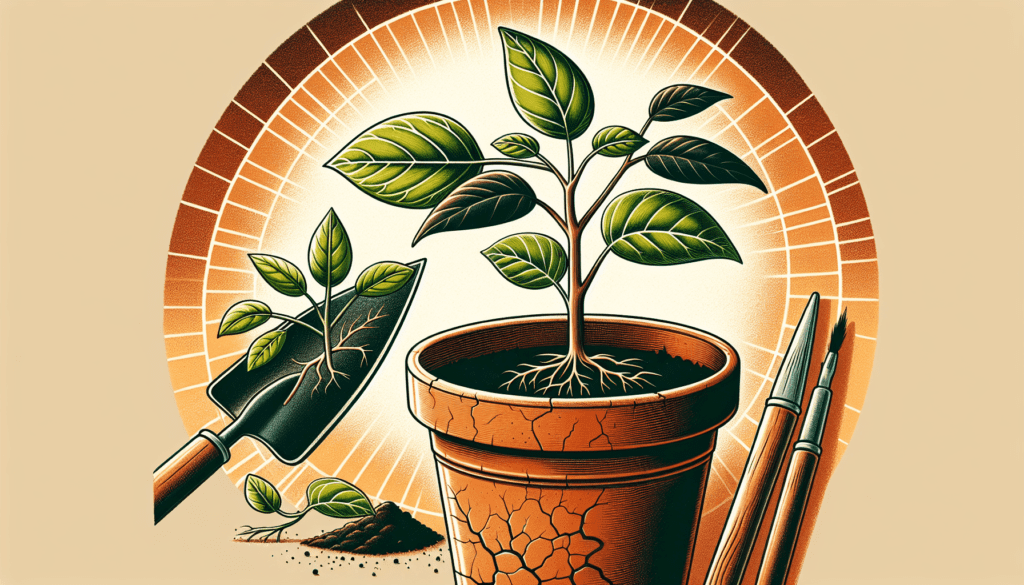Are you a plant enthusiast looking to expand your garden? Look no further! This article serves as a comprehensive guide to various plant propagation techniques. Whether you are a seasoned gardener or just starting out, this guide will provide you with all the information you need to successfully propagate your favorite plants. From stem cuttings to division and layering, we’ve got you covered. Get ready to learn the secrets of plant propagation and watch your garden flourish like never before.
Asexual Plant Propagation
Asexual plant propagation refers to the reproduction of plants without the involvement of seeds or sexual organs. This method allows gardeners and horticulturists to reproduce plants that have desirable traits, such as specific flower color or disease resistance. There are several techniques that can be used for asexual plant propagation, including cuttings, layering, division, and grafting.
Cuttings
Cuttings involve taking a portion of a stem or root from a parent plant and encouraging it to develop into a new plant. There are different types of cuttings that can be used, such as stem cuttings, leaf cuttings, and root cuttings. Stem cuttings are the most common and can be further classified as tip cuttings, nodal cuttings, or heel cuttings.
To prepare a stem cutting, you should first choose a healthy and disease-free parent plant. Using sharp and clean pruning shears, make a diagonal cut just above a node on the stem. Remove any lower leaves to prevent them from rotting and to increase the chances of root growth.
Layering
Layering is a technique used to propagate plants by encouraging a stem or branch to root while still attached to the parent plant. This method is often used for plants that have flexible stems and can bend down to reach the ground. There are different types of layering techniques that can be used, including simple layering, tip layering, and air layering.
Simple layering involves bending a flexible stem down towards the ground and burying a portion of it in the soil. The buried portion of the stem will develop roots over time, and once roots are established, it can be separated from the parent plant and grown independently.
Tip layering is a similar technique, but instead of burying the entire stem, only the tip is buried in the soil. This method is often used for plants with long trailing stems, such as certain varieties of ivy.
Air layering is a more advanced technique that involves creating a small incision on a stem, wrapping it with moist sphagnum moss, and covering it with a plastic bag or aluminum foil. This creates a humid environment that encourages the formation of roots. Once roots have developed, the stem can be cut below the rooted area and potted up as a new plant.
Division
Division is a propagation technique that involves separating a mature plant into two or more individual plants. This method is often used for perennials that form clumps of growth or have a rhizomatous root system. When dividing a plant, it is essential to ensure that each division has enough roots and foliage to survive independently.
To divide a plant, start by digging up the clump and gently separating the sections using a sharp knife or spade. It is essential to ensure that each division has its own set of roots and enough foliage to sustain itself. Once divided, the new plants can be potted up or replanted in the garden.
Grafting
Grafting is a technique used to combine the root system of one plant with the top growth (scion) of another. This method is often used to propagate plants that are difficult to root or to create new varieties with specific characteristics. There are several grafting techniques that can be used, including whip and tongue grafting, bark grafting, and bud grafting.
Whip and tongue grafting is a popular grafting technique that involves making a diagonal cut on both the scion and rootstock, creating a tongue-like structure. The two pieces are then connected, ensuring that the vascular tissues align, and secured with grafting tape or twine.
Bark grafting is another common grafting technique that involves removing a section of bark from the rootstock, making a corresponding cut on the scion, and connecting the two pieces. The join is then wrapped with grafting tape to hold it in place and facilitate healing.
Bud grafting is a technique used for grafting selected buds onto rootstock. This method is commonly used for fruit trees and involves making a T-shaped incision on the rootstock and inserting a bud from the scion into the cut. The bud is then wrapped with grafting tape to protect it and encourage healing.

Sexual Plant Propagation
Sexual plant propagation refers to the reproduction of plants using seeds and involves the transfer of pollen from the stamen (male reproductive organ) to the pistil (female reproductive organ). This method allows for genetic diversity and variation in offspring. There are several techniques that can be used for sexual plant propagation, including seeds, cross-pollination, and germination.
Seeds
Seeds are the most common method of sexual plant propagation. They are formed after the fertilization of the female ovule by the male pollen. Once the seeds are mature, they can be collected and sown to grow new plants. It is important to note that not all plants produce viable seeds, and some may require specific conditions, such as cold stratification or scarification, for successful germination.
When collecting seeds, it is important to select mature and healthy seeds. Remove any debris or plant material, and allow the seeds to dry thoroughly before storage. Store seeds in a cool, dry place, such as a sealed container in the refrigerator, to maintain their viability.
Cross-Pollination
Cross-pollination involves the transfer of pollen from the flower of one plant to the flower of another plant. This method allows for the mixing of genetic material and can result in offspring with different traits from the parent plants. Cross-pollination can occur naturally through wind, insects, or animals, or it can be done manually by hand-pollinating flowers.
To manually cross-pollinate flowers, identify the flowers that need to be pollinated and determine the timing when they are receptive. Use a small brush or cotton swab to transfer pollen from one flower to another, ensuring that the pollen is deposited on the stigma of the recipient flower. Take precautions to prevent contamination between different flowers or plant varieties.
Germination
Germination is the process by which a seed develops into a new plant. For successful germination, seeds require specific conditions, including moisture, an appropriate temperature range, and oxygen. It is essential to provide the optimal germination conditions to ensure successful seedling establishment.
When sowing seeds, it is important to choose a suitable growing medium and provide consistent moisture. Follow the specific germination requirements for each plant species, which may include soaking the seeds, stratifying them in the refrigerator, or scarifying the seed coat. Place the seeds in a warm and well-lit location, and monitor moisture levels to prevent them from drying out or becoming overly saturated.

Vegetative Plant Propagation
Vegetative plant propagation refers to the reproduction of plants using vegetative structures, such as bulbs, corms, rhizomes, and runners. This method allows for the production of genetically identical offspring and is commonly used to propagate plants with desirable traits, such as specific flower color or growth habit.
Bulbs
Bulbs are specialized underground structures that store nutrients and energy for the plant. They consist of a modified stem surrounded by fleshy scales, from which the roots and foliage emerge. To propagate plants from bulbs, the bulb can be divided into smaller sections, each containing a portion of the stem, scales, and a bud.
To divide a bulb, carefully dig it up and remove any excess soil. Separate the bulb into individual sections using your hands or a sharp knife, ensuring that each section has its own set of scales and a bud. It is essential to handle the bulbs with care to avoid damaging the scales or bud. Once divided, the new bulbs can be replanted at the appropriate depth.
Corms
Corms are similar to bulbs but lack fleshy scales. Instead, they have a solid, swollen stem base that stores nutrients and energy. Corms can be propagated by carefully removing the cormels or small corms that develop around the parent corm. These cormels can be planted separately and will grow into new plants.
To propagate corms, gently dig up the parent plant and carefully separate the cormels from the main corm. It is important to handle the cormels carefully to avoid any damage. Plant the cormels at the appropriate depth and ensure that they receive adequate moisture and light for successful growth.
Rhizomes
Rhizomes are horizontal, underground stems that produce roots and shoots at various intervals. They are commonly used for the propagation of plants such as irises, ginger, and bamboo. To propagate plants from rhizomes, portions of the rhizome can be divided and replanted, each containing at least one bud or shoot.
To divide rhizomes, gently dig up the parent plant and identify suitable sections for propagation. Cut the rhizome into smaller sections using a sharp knife, ensuring that each section has a healthy bud or shoot. It is important to handle the rhizomes with care to prevent any damage. Once divided, the new rhizomes can be replanted and given appropriate care.
Runners
Runners, also known as stolons, are horizontal stems that develop above the ground and produce new plants at nodes along their length. This method of plant propagation is commonly seen in strawberries, spider plants, and spiderwort. Runners are easy to identify as they extend outwards from the main plant and produce new plantlets at regular intervals.
To propagate plants from runners, simply identify the plantlets along the runner and gently separate them from the parent plant. It is important to handle the plantlets with care to avoid damaging the delicate roots. Transplant the plantlets into their own pots or directly into the soil, ensuring they receive adequate moisture and light for successful growth.
By utilizing the various techniques of asexual, sexual, and vegetative plant propagation, gardeners and horticulturists have the ability to propagate a wide range of plants. Each method has its own advantages and considerations, and understanding their applications can provide valuable skills and knowledge for any plant enthusiast. Whether you are looking to create new varieties, expand your garden, or simply share your favorite plants with others, plant propagation techniques are an essential tool in your gardening arsenal. So roll up your sleeves, grab your pruners, and start propagating – the possibilities are endless!

